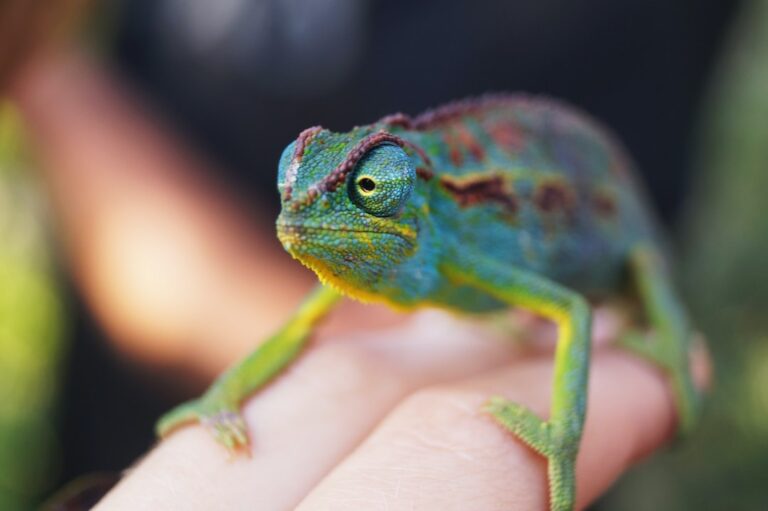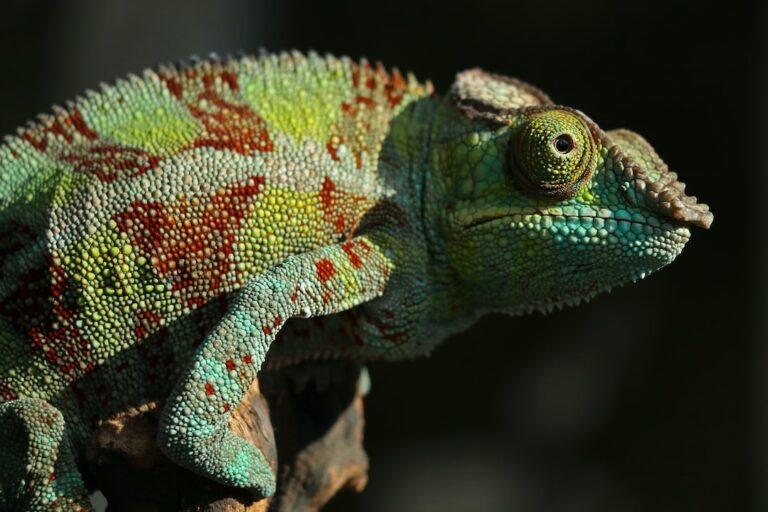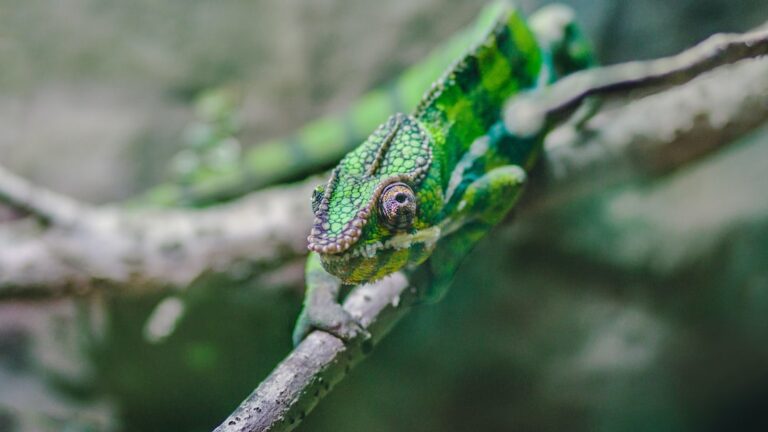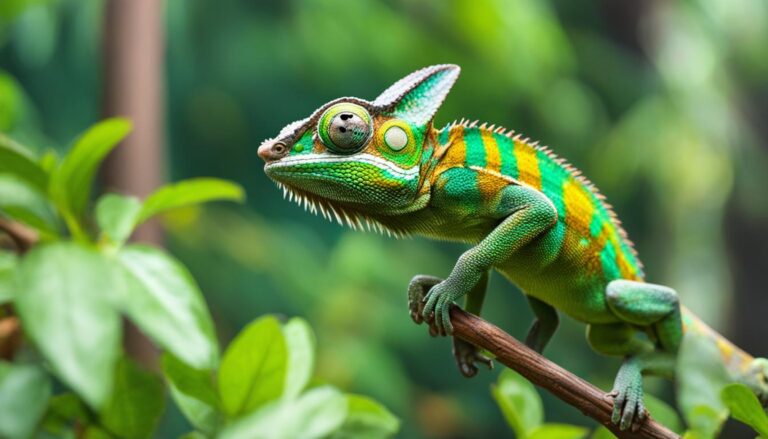Are Chameleons Color Blind?
Chameleons are fascinating creatures known for their ability to change color and blend in with their surroundings. They belong to the family Chamaeleonidae and are native to Africa, Madagascar, and parts of southern Europe and Asia. Chameleons are known for their unique physical characteristics, such as their long tongues, independently moving eyes, and prehensile tails.
One of the most remarkable abilities of chameleons is their ability to change color. This ability is not just for camouflage, but also for communication and thermoregulation. Chameleons have specialized cells called chromatophores in their skin that contain pigments. By expanding or contracting these cells, chameleons can change the color of their skin. This allows them to blend in with their surroundings and avoid predators.
Table of Contents
Understanding Chameleon Vision and Perception
Chameleons have unique eyes that are capable of independent movement. Each eye can move and focus on different objects simultaneously, giving chameleons a 360-degree field of vision. This allows them to have a wide range of vision and be aware of their surroundings at all times.
Chameleon eyes are also capable of seeing in two different directions at once. This gives them a stereoscopic vision, which helps them accurately judge distances and accurately capture prey. Their eyes are also able to rotate almost 180 degrees, allowing them to scan their environment without having to move their head.
Do Chameleons See Color?
Contrary to popular belief, chameleons do see color. However, their color vision is different from that of humans. Chameleons have a limited color range compared to humans, as they only have two types of color receptors in their eyes: green and blue.
This means that chameleons cannot see the full spectrum of colors that humans can. They are unable to see reds and oranges, as they lack the necessary color receptors. However, they can see shades of green and blue, which are important for their survival in their natural habitat.
The Role of Color in Chameleon Camouflage
Color plays a crucial role in chameleon camouflage. By changing their skin color, chameleons can blend in with their surroundings and become almost invisible to predators. This ability allows them to hide from potential threats and increases their chances of survival.
Chameleons use their color-changing ability not only for camouflage but also for communication. They can change their color to signal aggression, submission, or mating readiness to other chameleons. This helps them establish dominance and attract potential mates.
The Science of Chameleon Color Vision
The science behind chameleon color vision lies in the different types of color receptors in their eyes. Chameleons have specialized cells called cone cells that are responsible for detecting colors. These cone cells contain pigments that respond to different wavelengths of light.
Chameleons have two types of cone cells: green-sensitive and blue-sensitive. The green-sensitive cone cells are most sensitive to wavelengths of light around 530 nanometers, which corresponds to the color green. The blue-sensitive cone cells are most sensitive to wavelengths of light around 440 nanometers, which corresponds to the color blue.
Chameleons and Their Ability to Detect Ultraviolet Light
In addition to their ability to see colors within the visible spectrum, chameleons also have the ability to detect ultraviolet (UV) light. UV light is invisible to the human eye but is present in the environment. Many animals, including insects and birds, can see UV light, which helps them navigate and find food.
Chameleons have specialized photoreceptor cells in their eyes that are sensitive to UV light. This allows them to see patterns and markings on flowers, leaves, and potential prey that are invisible to humans. The ability to detect UV light is particularly useful for chameleons when it comes to finding food and identifying potential mates.
Chameleon Eye Anatomy and Function
Chameleon eyes have a unique anatomy and function that sets them apart from human eyes. Chameleons have large, bulging eyes that are covered by a transparent membrane called the cornea. The cornea protects the eye and helps focus light onto the retina.
The retina is the innermost layer of the eye and contains the photoreceptor cells responsible for detecting light. In chameleons, the retina is composed of both rod cells and cone cells. Rod cells are responsible for detecting light intensity and movement, while cone cells are responsible for detecting colors.
Comparing Chameleon Vision to Human Vision
Chameleon vision differs from human vision in several ways. While humans have three types of cone cells that allow us to see a wide range of colors, chameleons only have two types of cone cells, limiting their color perception. Chameleons also have a wider field of vision than humans due to their independently moving eyes.
However, chameleons have poorer visual acuity compared to humans. Their eyesight is not as sharp, and they rely more on movement and color changes to detect prey and avoid predators. Humans, on the other hand, have better depth perception and can see fine details.
Chameleon Color Perception in Different Lighting Conditions
Chameleon color perception can vary depending on the lighting conditions. In bright light, chameleons can see colors more accurately and distinguish between different shades of green and blue. However, in low light conditions, their color perception becomes less accurate, and they rely more on movement and contrast to detect prey.
This change in color perception in different lighting conditions can affect chameleon behavior. For example, chameleons may be more active and hunt more during the day when there is ample light. In contrast, they may be less active and rely on their camouflage to hide from predators during the night when there is less light.
Are Chameleons Truly Color Blind?
In conclusion, chameleons are not truly color blind. While they have a limited color range compared to humans, they can still see and distinguish between different shades of green and blue. Their ability to change color and blend in with their surroundings is a remarkable adaptation that helps them survive in their natural habitat.
Chameleon vision and perception are unique and specialized for their specific needs. Their independently moving eyes, wide field of vision, and ability to detect UV light all contribute to their survival and success as a species. While their color vision may not be as advanced as that of humans, it is perfectly suited to their environment and allows them to thrive.
If you’re interested in learning more about reptiles, you might also enjoy reading the article “Do Iguanas Run on Their Back Legs?” This fascinating piece explores the unique locomotion of iguanas and delves into the question of whether they can actually run on their hind legs. To find out more, click here.







